Jianzhong He
Diff5T: Benchmarking Human Brain Diffusion MRI with an Extensive 5.0 Tesla K-Space and Spatial Dataset
Dec 09, 2024

Abstract:Diffusion magnetic resonance imaging (dMRI) provides critical insights into the microstructural and connectional organization of the human brain. However, the availability of high-field, open-access datasets that include raw k-space data for advanced research remains limited. To address this gap, we introduce Diff5T, a first comprehensive 5.0 Tesla diffusion MRI dataset focusing on the human brain. This dataset includes raw k-space data and reconstructed diffusion images, acquired using a variety of imaging protocols. Diff5T is designed to support the development and benchmarking of innovative methods in artifact correction, image reconstruction, image preprocessing, diffusion modelling and tractography. The dataset features a wide range of diffusion parameters, including multiple b-values and gradient directions, allowing extensive research applications in studying human brain microstructure and connectivity. With its emphasis on open accessibility and detailed benchmarks, Diff5T serves as a valuable resource for advancing human brain mapping research using diffusion MRI, fostering reproducibility, and enabling collaboration across the neuroscience and medical imaging communities.
Bundle-specific Tractogram Distribution Estimation Using Higher-order Streamline Differential Equation
Jul 06, 2023Abstract:Tractography traces the peak directions extracted from fiber orientation distribution (FOD) suffering from ambiguous spatial correspondences between diffusion directions and fiber geometry, which is prone to producing erroneous tracks while missing true positive connections. The peaks-based tractography methods 'locally' reconstructed streamlines in 'single to single' manner, thus lacking of global information about the trend of the whole fiber bundle. In this work, we propose a novel tractography method based on a bundle-specific tractogram distribution function by using a higher-order streamline differential equation, which reconstructs the streamline bundles in 'cluster to cluster' manner. A unified framework for any higher-order streamline differential equation is presented to describe the fiber bundles with disjoint streamlines defined based on the diffusion tensor vector field. At the global level, the tractography process is simplified as the estimation of bundle-specific tractogram distribution (BTD) coefficients by minimizing the energy optimization model, and is used to characterize the relations between BTD and diffusion tensor vector under the prior guidance by introducing the tractogram bundle information to provide anatomic priors. Experiments are performed on simulated Hough, Sine, Circle data, ISMRM 2015 Tractography Challenge data, FiberCup data, and in vivo data from the Human Connectome Project (HCP) data for qualitative and quantitative evaluation. The results demonstrate that our approach can reconstruct the complex global fiber bundles directly. BTD reduces the error deviation and accumulation at the local level and shows better results in reconstructing long-range, twisting, and large fanning tracts.
Reconstructing the somatotopic organization of the corticospinal tract remains a challenge for modern tractography methods
Jun 15, 2023Abstract:The corticospinal tract (CST) is a critically important white matter fiber tract in the human brain that enables control of voluntary movements of the body. Diffusion MRI tractography is the only method that enables the study of the anatomy and variability of the CST pathway in human health. In this work, we explored the performance of six widely used tractography methods for reconstructing the CST and its somatotopic organization. We perform experiments using diffusion MRI data from the Human Connectome Project. Four quantitative measurements including reconstruction rate, the WM-GM interface coverage, anatomical distribution of streamlines, and correlation with cortical volumes to assess the advantages and limitations of each method. Overall, we conclude that while current tractography methods have made progress toward the well-known challenge of improving the reconstruction of the lateral projections of the CST, the overall problem of performing a comprehensive CST reconstruction, including clinically important projections in the lateral (hand and face area) and medial portions (leg area), remains an important challenge for diffusion MRI tractography.
DeepRGVP: A Novel Microstructure-Informed Supervised Contrastive Learning Framework for Automated Identification Of The Retinogeniculate Pathway Using dMRI Tractography
Nov 15, 2022Abstract:The retinogeniculate pathway (RGVP) is responsible for carrying visual information from the retina to the lateral geniculate nucleus. Identification and visualization of the RGVP are important in studying the anatomy of the visual system and can inform treatment of related brain diseases. Diffusion MRI (dMRI) tractography is an advanced imaging method that uniquely enables in vivo mapping of the 3D trajectory of the RGVP. Currently, identification of the RGVP from tractography data relies on expert (manual) selection of tractography streamlines, which is time-consuming, has high clinical and expert labor costs, and affected by inter-observer variability. In this paper, we present what we believe is the first deep learning framework, namely DeepRGVP, to enable fast and accurate identification of the RGVP from dMRI tractography data. We design a novel microstructure-informed supervised contrastive learning method that leverages both streamline label and tissue microstructure information to determine positive and negative pairs. We propose a simple and successful streamline-level data augmentation method to address highly imbalanced training data, where the number of RGVP streamlines is much lower than that of non-RGVP streamlines. We perform comparisons with several state-of-the-art deep learning methods that were designed for tractography parcellation, and we show superior RGVP identification results using DeepRGVP.
White Matter Tracts are Point Clouds: Neuropsychological Score Prediction and Critical Region Localization via Geometric Deep Learning
Jul 06, 2022

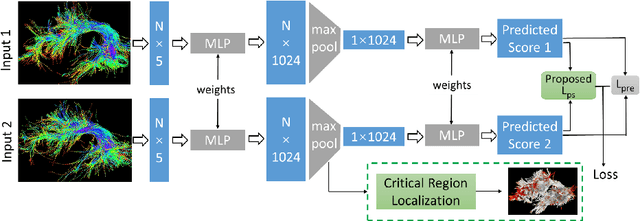
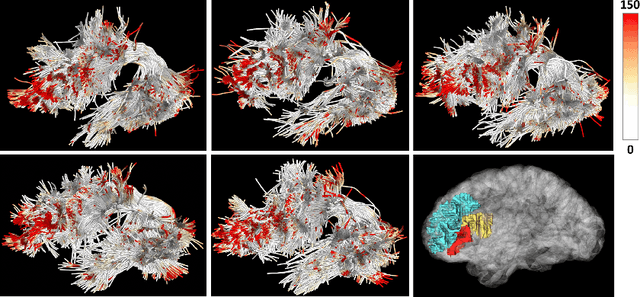
Abstract:White matter tract microstructure has been shown to influence neuropsychological scores of cognitive performance. However, prediction of these scores from white matter tract data has not been attempted. In this paper, we propose a deep-learning-based framework for neuropsychological score prediction using microstructure measurements estimated from diffusion magnetic resonance imaging (dMRI) tractography, focusing on predicting performance on a receptive vocabulary assessment task based on a critical fiber tract for language, the arcuate fasciculus (AF). We directly utilize information from all points in a fiber tract, without the need to average data along the fiber as is traditionally required by diffusion MRI tractometry methods. Specifically, we represent the AF as a point cloud with microstructure measurements at each point, enabling adoption of point-based neural networks. We improve prediction performance with the proposed Paired-Siamese Loss that utilizes information about differences between continuous neuropsychological scores. Finally, we propose a Critical Region Localization (CRL) algorithm to localize informative anatomical regions containing points with strong contributions to the prediction results. Our method is evaluated on data from 806 subjects from the Human Connectome Project dataset. Results demonstrate superior neuropsychological score prediction performance compared to baseline methods. We discover that critical regions in the AF are strikingly consistent across subjects, with the highest number of strongly contributing points located in frontal cortical regions (i.e., the rostral middle frontal, pars opercularis, and pars triangularis), which are strongly implicated as critical areas for language processes.
Memory-Based Label-Text Tuning for Few-Shot Class-Incremental Learning
Jul 03, 2022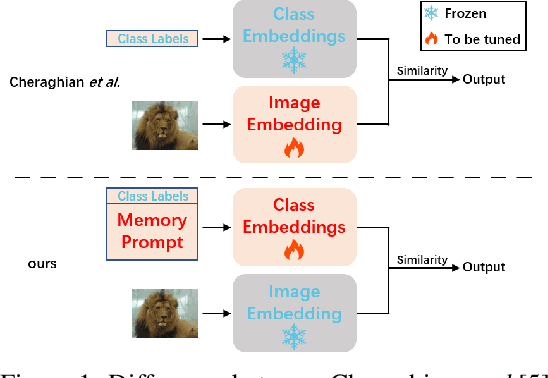

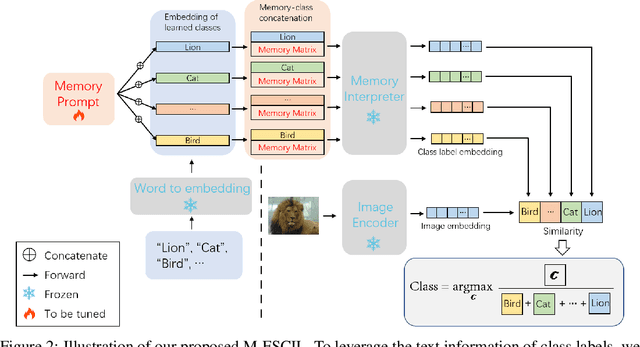

Abstract:Few-shot class-incremental learning(FSCIL) focuses on designing learning algorithms that can continually learn a sequence of new tasks from a few samples without forgetting old ones. The difficulties are that training on a sequence of limited data from new tasks leads to severe overfitting issues and causes the well-known catastrophic forgetting problem. Existing researches mainly utilize the image information, such as storing the image knowledge of previous tasks or limiting classifiers updating. However, they ignore analyzing the informative and less noisy text information of class labels. In this work, we propose leveraging the label-text information by adopting the memory prompt. The memory prompt can learn new data sequentially, and meanwhile store the previous knowledge. Furthermore, to optimize the memory prompt without undermining the stored knowledge, we propose a stimulation-based training strategy. It optimizes the memory prompt depending on the image embedding stimulation, which is the distribution of the image embedding elements. Experiments show that our proposed method outperforms all prior state-of-the-art approaches, significantly mitigating the catastrophic forgetting and overfitting problems.
Switchable Representation Learning Framework with Self-compatibility
Jun 16, 2022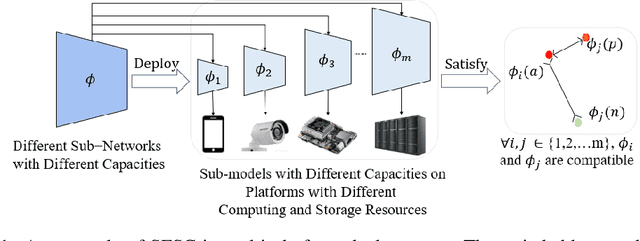


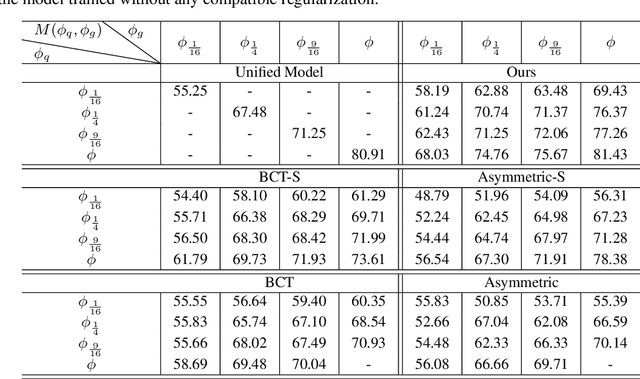
Abstract:Real-world visual search systems involve deployments on multiple platforms with different computing and storage resources. Deploying a unified model that suits the minimal-constrain platforms leads to limited accuracy. It is expected to deploy models with different capacities adapting to the resource constraints, which requires features extracted by these models to be aligned in the metric space. The method to achieve feature alignments is called "compatible learning". Existing research mainly focuses on the one-to-one compatible paradigm, which is limited in learning compatibility among multiple models. We propose a Switchable representation learning Framework with Self-Compatibility (SFSC). SFSC generates a series of compatible sub-models with different capacities through one training process. The optimization of sub-models faces gradients conflict, and we mitigate it from the perspective of the magnitude and direction. We adjust the priorities of sub-models dynamically through uncertainty estimation to co-optimize sub-models properly. Besides, the gradients with conflicting directions are projected to avoid mutual interference. SFSC achieves state-of-art performance on the evaluated dataset.
T-SVDNet: Exploring High-Order Prototypical Correlations for Multi-Source Domain Adaptation
Jul 30, 2021



Abstract:Most existing domain adaptation methods focus on adaptation from only one source domain, however, in practice there are a number of relevant sources that could be leveraged to help improve performance on target domain. We propose a novel approach named T-SVDNet to address the task of Multi-source Domain Adaptation (MDA), which is featured by incorporating Tensor Singular Value Decomposition (T-SVD) into a neural network's training pipeline. Overall, high-order correlations among multiple domains and categories are fully explored so as to better bridge the domain gap. Specifically, we impose Tensor-Low-Rank (TLR) constraint on a tensor obtained by stacking up a group of prototypical similarity matrices, aiming at capturing consistent data structure across different domains. Furthermore, to avoid negative transfer brought by noisy source data, we propose a novel uncertainty-aware weighting strategy to adaptively assign weights to different source domains and samples based on the result of uncertainty estimation. Extensive experiments conducted on public benchmarks demonstrate the superiority of our model in addressing the task of MDA compared to state-of-the-art methods.
Multi-Target Domain Adaptation with Collaborative Consistency Learning
Jun 07, 2021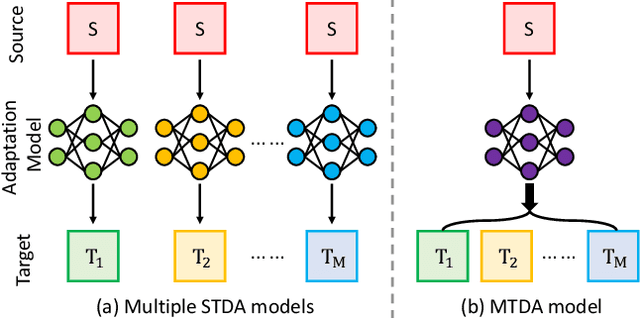



Abstract:Recently unsupervised domain adaptation for the semantic segmentation task has become more and more popular due to high-cost of pixel-level annotation on real-world images. However, most domain adaptation methods are only restricted to single-source-single-target pair, and can not be directly extended to multiple target domains. In this work, we propose a collaborative learning framework to achieve unsupervised multi-target domain adaptation. An unsupervised domain adaptation expert model is first trained for each source-target pair and is further encouraged to collaborate with each other through a bridge built between different target domains. These expert models are further improved by adding the regularization of making the consistent pixel-wise prediction for each sample with the same structured context. To obtain a single model that works across multiple target domains, we propose to simultaneously learn a student model which is trained to not only imitate the output of each expert on the corresponding target domain, but also to pull different expert close to each other with regularization on their weights. Extensive experiments demonstrate that the proposed method can effectively exploit rich structured information contained in both labeled source domain and multiple unlabeled target domains. Not only does it perform well across multiple target domains but also performs favorably against state-of-the-art unsupervised domain adaptation methods specially trained on a single source-target pair
Multi-Source Domain Adaptation with Collaborative Learning for Semantic Segmentation
Mar 16, 2021



Abstract:Multi-source unsupervised domain adaptation~(MSDA) aims at adapting models trained on multiple labeled source domains to an unlabeled target domain. In this paper, we propose a novel multi-source domain adaptation framework based on collaborative learning for semantic segmentation. Firstly, a simple image translation method is introduced to align the pixel value distribution to reduce the gap between source domains and target domain to some extent. Then, to fully exploit the essential semantic information across source domains, we propose a collaborative learning method for domain adaptation without seeing any data from target domain. In addition, similar to the setting of unsupervised domain adaptation, unlabeled target domain data is leveraged to further improve the performance of domain adaptation. This is achieved by additionally constraining the outputs of multiple adaptation models with pseudo labels online generated by an ensembled model. Extensive experiments and ablation studies are conducted on the widely-used domain adaptation benchmark datasets in semantic segmentation. Our proposed method achieves 59.0\% mIoU on the validation set of Cityscapes by training on the labeled Synscapes and GTA5 datasets and unlabeled training set of Cityscapes. It significantly outperforms all previous state-of-the-arts single-source and multi-source unsupervised domain adaptation methods.
 Add to Chrome
Add to Chrome Add to Firefox
Add to Firefox Add to Edge
Add to Edge